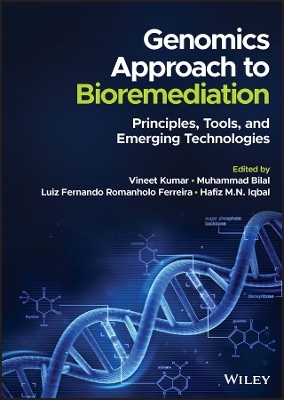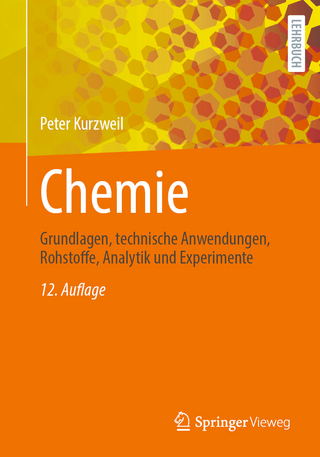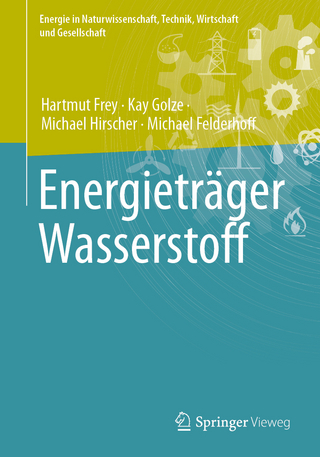
Genomics Approach to Bioremediation
John Wiley & Sons Inc (Verlag)
978-1-119-85210-0 (ISBN)
In recent years, the application of genomics to biodegradation and bioremediation research has led to a better understanding of the metabolic capabilities of microorganisms, their interactions with hazardous and toxic chemical compounds, and their adaptability to changing environmental conditions.
Genomics Approach to Bioremediation: Principles, Tools, and Emerging Technologies provides comprehensive and up-to-date information on cutting-edge technologies and approaches in bioremediation and biodegradation of environmental pollutants. Edited by prominent researchers in the field, this authoritative reference examines advanced genomics technologies, next-generation sequencing (NGS), and state-of-the-art bioinformatics tools while offering valuable insights into the unique functional attributes of different microbial communities and their impact on the removal of chemical contaminants.
Each chapter includes numerous high-quality illustrations, detailed tables, extensive references, and step-by-step descriptions of various microbial metabolic pathways of degradation and biotransformation of environments containing various inorganic, metallic, organometallic, and organic hydrocarbon contaminants.
• Describes methodologies and underlying theory for the remediation, detoxification, and
degradation of contaminated environments
• Covers new genomics technologies that address nutrient removal, resource recovery, and
other major trends in environmental cleanup
• Highlights recent advances in microbial biotechnological approaches including the latest
description of the relationship between microbes and the environment focusing on their impact
on ecosystem services.
• Offers perspectives on energy saving, production, sustainability, and community involvement
• Discusses current challenges and future directions in the field of bioremediation
Genomics Approach to Bioremediation: Principles, Tools, and Emerging Technologies is an essential resource for biochemical and environmental engineers, environmental microbiologists, academic researchers, process and treatment plant managers, policymakers, and industry professionals working in the areas of microbial degradation, bioremediation, and phytoremediation.
Vineet Kumar is an Assistant Professor in the School of Engineering & Sciences at GD Goenka University, Gurugram, Haryana, India. He has published more than 110 scientific contributions in various fields of science and engineering, including bioremediation, phytoremediation, metagenomics, wastewater treatment, environmental monitoring, and waste management. Muhammad Bilal is an Assistant Professor in the Institute of Chemical Technology and Engineering, Faculty of Chemical Technology, Poznan University of Technology, Poznan, Poland. He has published widely in areas such as environmental biotechnology, environmental bioengineering, nanotechnology, bio-catalysis, enzyme engineering, and bioremediation of hazardous and emerging pollutants. Luiz Fernando Romanholo Ferreira is an Associate Professor at Tiradentes University and a researcher at the Institute for Technology and Research (ITP), Brazil. Dr. Ferreira serves on the editorial board of the World Journal of Microbiology and Biotechnology and is a Review Editor for Frontiers in Microbiology. Hafiz M.N. Iqbal is a Professor in the School of Engineering and Sciences at Tecnologico de Monterrey, Mexico. Dr. Iqbal’s research group is engaged in environmental engineering, bioengineering, biomedical engineering, materials science, enzyme engineering, bio catalysis, bioremediation, algal biotechnology, and applied biotechnology research.
About the Editors xxiii
List of Contributors xxv
Preface xxxiii
Acknowledgements xxxix
Part 1 Fundamentals of Metagenomics and Bioremediation 1
1 Application of Bioremediation for Environmental Clean-Up: Issues, Recent Developments, and the Way Forward 3
Sneha Bandyopadhyay, Vivek Rana, and Subodh Kumar Maiti
1.1 Introduction 3
1.2 Bioremediation: A Sustainable Approach 4
1.3 Importance of Vegetation for Bioremediation 8
1.4 Application of Bioremediation to Clean Up Environmental Pollutants 8
1.5 Advantages and Disadvantages of Bioremediation Technology 9
1.6 Recent Advancements in Bioremediation Technology 10
1.7 Conclusion 12
References 12
2 Omics in Biomethanation and Environmental Remediation 17
Manan Kaur Ghai, Indu Shekhar Thakur, and Shaili Srivastava
2.1 Introduction 17
2.2 Feedstocks Used 18
2.3 Microbiology and Biochemical Reactions in Anaerobic Digestions 21
2.4 Omics in Biomethanation and Bioremediation 23
2.5 Role of Factors in Anaerobic Digestions in Biomethanation 26
2.6 Inhibitory Substances for Anaerobic Digestion 28
2.7 Degradation and Bioremediation of Toxic Compounds for Enhanced Production of Biomethanation 29
2.8 Circular Economy Perspective in Biogas Production 30
2.9 Conclusion 32
References 32
3 Enzyme Immobilization: An Effective Platform to Improve the Reusability and Catalytic Efficiency of Enzymes 35
Nisha Bhardwaj, Komal Agrawal, and Pradeep Verma
3.1 Introduction 35
3.2 Immobilization of Enzymes 36
3.3 Aspects Affecting the Performance of Immobilized Enzyme 37
3.4 Factors Contributing Toward the Immobilized Enzyme Activity Enhancement 40
3.5 Immobilized Enzyme Applications 44
3.6 Conclusion 44
References 46
4 Biostimulation and Bioaugmentation: Case Studies 53
Ana Maria Queijeiro López and Amanda Lys dos Santos Silva
4.1 Introduction 53
4.2 Biostimulation 54
4.3 Bioagumentation 57
4.4 Commercially Available Bioremediation Agents 63
4.5 Conclusions 65
References 65
5 Plant Microbe Synergism for Arsenic Stress Amelioration in Crop Plants 69
Vandana Anand, Jasvinder Kaur, Sonal Srivastava, Varsha Dharmesh, Vidisha Bist, Akshita Maheshwari, Sumit Yadav, and Suchi Srivastava
5.1 Introduction 69
5.2 Distribution of Arsenic in Soil and Water 70
5.3 Methods of Arsenic Remediation 71
5.4 Arsenic-Induced Toxicity in Crop Plants 73
5.5 Arsenic Remediation Through Mineral Fertilization 74
5.6 Bioremediation 76
5.7 Plant–Microbe Interaction and Their Role in Reducing As Toxicity in Crop Plants 80
5.8 Plant–Microbe Interaction as a Boon for Arsenic Remediation 82
5.9 Microbial Methylation of Arsenic in Soil and its Reduced Uptake in Plants 83
5.10 Conclusion 85
References 85
6 Metagenomic Characterization and Applications of Microbial Surfactants in Remediation of Potentially Toxic Heavy Metals for Environmental Safety: Recent Advances and Challenges 89
Geetansh Sharma, Kirti Shyam, Saurabh Thakur, Manu Yadav, Saransh Nair, Navneet Kumar, Himani Chandel, and Gaurav Saxena
6.1 Introduction 89
6.2 Biosurfactants’ Characteristics 90
6.3 Classification of Biosurfactants 91
6.4 Screening of Microorganisms for Biosurfactants Production 96
6.5 Metagenomic Characterization of Biosurfactant-Producing Microorganisms 99
6.6 Biosynthesis of Biosurfactants 100
6.7 Characterization of Biosurfactants 101
6.8 Factors Influencing Biosurfactants Production 104
6.9 Applications of Biosurfactants in Heavy Metals Environmental Remediation 105
6.10 Challenges in Cost-Effective Production of Biosurfactants 107
6.11 Future Research Needs 110
6.12 Conclusions 110
References 111
Part 2 Metagenomics in Environmental Cleanup 125
7 Metagenomic Approaches Applied to Bioremediation of Xenobiotics 127
Júlia Ronzella Ottoni, Márcio Thomaz dos Santos Varjão, Aline Cavalcanti de Queiroz, Alysson Wagner Fernandes Duarte, and Michel Rodrigo Zambrano Passarini
7.1 Introduction 127
7.2 Metagenomic Approaches in Bioremediation Processes 129
7.3 Metagenomics in the Hydrocarbon Degradation 131
7.4 Metagenomic Approaches in the Drugs Degradation 133
7.5 Metagenomic Approaches in the Dye Degradation 134
7.6 Metagenomic Approaches in the Pesticides Degradation 135
7.7 Metagenomics in Heavy Metal Biorremediation 136
References 137
8 Omics Approaches for Microalgal Applications in Wastewater Treatment 143
Banani Ray Chowdhury, Sudip Das, Shreyan Bardhan, and Dibyajit Lahiri
8.1 Introduction 143
8.2 Concept on Microalgal Biofilms 144
8.3 Factors Influencing Nutrient Extraction and Microalgal Growth 148
8.4 Mechanism of Microalgal Remediation 148
8.5 Multi-Omics Approach 150
8.6 Conclusion 153
References 153
9 Microbial Community Profiling in Wastewater of Effluent Treatment Plant 157
Hansa Mathur, Navneet Joshi, and Sarita Khaturia
9.1 Source of Wastewater 157
9.2 Wastewater Treatment Plant 158
9.3 Wastewater Treatment Facilities Have a Wide Range of Microbial Diversity 159
9.4 Microbial Composition in WWTPs 161
9.5 Screening, Selection, and Identification of Microbial Communities 165
9.6 Health Problem for Wastewater Treatment Employees 172
9.7 Conclusion 174
9.8 Future Prospective 174
References 175
10 Mining of Novel Microbial Enzymes Using Metagenomics Approach for Efficient Bioremediation: An Overview 183
Shruti Dwivedi, Supriya Gupta, Aiman Tanveer, Gautam Anand, Sangeeta Yadav, and Dinesh Yadav
10.1 Introduction 183
10.2 Omics for Microbial Enzymes in Bioremediation 184
10.3 Implementing Metagenomics for Énvironmental Remediations 186
10.4 Metagenomics, Microbial Enzymes, and Bioremediation 189
10.5 Meta –Omics Advances for Bioremediation 192
10.6 Conclusion 194
References 195
11 Bioremediation Approaches for Genomic Microalgal Applications in Wastewater Treatment 199
N. Nirmala, S.S. Dawn, and J. Arun
11.1 Introduction 199
11.2 Implantation of Microalgae in Wastewater Treatment 200
11.3 Strategies to Enhance the Removal of Nutrients 201
11.4 Mechanism of Nitrogen and Phosphorus Removal from Wastewater 202
11.5 Biofuel Production with Simultaneous Wastewater Treatment 203
11.6 Genetic Engineering and Bioremediation Approaches 204
11.7 Bioremediation Approaches in Value-Added Products Formation 205
11.8 Economic Feasibility of Nutrient Removal Methods 206
11.9 Conclusion 206
References 207
12 Application of Microbial Enzymes in Wastewater Treatment 209
Saloni Sahal, Sarita Khaturia, and Navneet Joshi
12.1 Introduction 209
12.2 Types and Functions of Microbial Enzymes 211
12.3 Major Contaminants in Waste Water 212
12.4 Technologies Used for Enzymatic Treatment of Waste Water 216
12.5 Enzymatic Treatment Benefits 220
12.6 Conclusion 221
12.7 Future Perspectives 222
References 222
13 Microbial Biodegradation and Biotransformation of Petroleum Hydrocarbons: Progress, Prospects, and Challenges 229
Kuruvalli Gouthami, A.M.M. Mallikarjunaswamy, Ram Naresh Bhargava, Luiz Fernando Romanholo Ferreira, Abbas Rahdar, Ganesh Dattatraya Saratale, Paul Olusegun Bankole, and Sikandar I. Mulla
13.1 Introduction 229
13.2 Pollution and Toxic Effect of Petroleum Hydrocarbons 232
13.3 Taxonomic Relationships of Hydrocarbon-Utilizing Microorganisms 234
13.4 Biotransformation 235
13.5 Microbial-Mediated Remediation of Petroleum Hydrocarbons 235
13.6 Metagenomics Approaches 243
13.7 Current and Future Prospective 244
Acknowledgments 245
References 245
14 Sewage Treatment System: Recent Trends, Challenges, and Opportunities 249
Teow Yeit Haan, Ho Kah Chun, and Chien Hwa Chong
14.1 Introduction 249
14.2 Important Monitoring and Water Quality Parameters in Biological Sewage Treatment Systems 251
14.3 Biological Treatment Option for Sewage Treatment Systems 253
14.4 Challenges and Opportunities with Current Biological Sewage Treatment Processes 262
14.5 Conclusion 264
Acknowledgments 264
Abbreviation 265
References 265
15 Omics Approach in Nano-Bioremediation of Persistent Organic Pollutants 271
Jyoti, Nikita Yadav, Indu Shekhar, and Shaili Srivastava
15.1 Introduction 271
15.2 POP Into the Environment 272
15.3 Nano-bioremediation of POPs 273
15.4 Types of POPs and Their Degradation Pathways in the Environment 274
15.5 Nanomaterial Used in Thermal Degradation of Persistent Organic Pollutants 283
15.6 Conclusion 289
References 290
16 Application of Genetically Modified Microorganisms for Bioremediation of Heavy Metals from Wastewater 295
Ankita Bhatt, Jugnu Shandilya, S.K. Singal, and Sanjeev Kumar Prajapati
16.1 Introduction 295
16.2 Bioremediation 296
16.3 Genetically Modified Microorganisms (GMMs) for Bioremediation 302
16.4 GMMs for Bioremediation of Heavy Metal-Contaminated Wastewater 303
16.5 Case Studies 305
16.6 Conclusions 312
Acknowledgments 313
References 313
17 Biostimulation and Bioaugmentation of Petroleum Hydrocarbons: From Microbial Growth to Genomics 321
Isabela Karina Della-Flora, Vanessa Kristine de Oliveira Schmidt, Karina Cesca, Maikon Kelbert, Débora de Oliveira, and Cristiano José de Andrade
17.1 Introduction 321
17.2 Impact of Petroleum Hydrocarbons on Microbial Diversity 322
17.3 Genomic Approaches 323
17.4 Soil Bioremediation 328
17.5 Groundwater and Surface Water Bioremediation 332
17.6 Organic and Inorganic Amendments to Biostimulation 335
17.7 Conclusion 338
References 338
18 Omics Approach in Bioremediation of Heavy Metals (HMs) in Industrial Wastewater 343
Nikita Yadav, Jyoti, Indu Shekhar, and Shaili Srivastava
18.1 Introduction 343
18.2 Nomenclature Used 344
18.3 Heavy Metals as Pollutant Into the Water Environment: Sources and Pathways 344
18.4 Toxicity and Physio-Biochemical Effects of Heavy Metals 348
18.5 Existing Technologies for the Removal of Heavy Metals from the Environmental Matrices 350
18.6 Omics Approach in the Bioremediation of Heavy Metals 353
18.7 Nano-Bioremediation of Heavy Metals: An Emerging Approach 356
18.8 Recent Advancement and Development of Nano-Bioremediation of HMs 356
18.9 Conclusion 358
References 358
Part 3 Recent Trends and Future Outlook in Metagenomics to Bioremediation 363
19 CRISPR/Cas Editing in Relation to Phytoremediation: Progress and Prospects 365
Satarupa Dey, Uttpal Anand, Devendra Kumar Pandey, Mimosa Ghorai, Mahipal S.Shekhawat, Muddasarul Hoda, Potshangbam Nongdam, and Abhijit Dey
19.1 Introduction 365
19.2 Conventional Molecular Tools for Creating Genetically Modified Plants 366
19.3 CRISPR-Mediated Gene Editing Technique 367
19.4 Target Genes of CRISPR-Mediated Genetic Modification 368
19.5 CRISPR-Mediated Strategies for Phytoremediation 370
19.6 Role CRISPR-Mediated Strategies in Generating Stress Tolerant Plants 371
19.7 Concluding Remarks and Future Perspectives 372
References 372
20 Biosensors as a Principal Tool for Bioremediation Monitoring 379
Simranjeet Singh, Monika Thakur, Daljeet Singh Dhanjal, Ruby Angurana, Dhriti Kapoor, Vaidehi Katoch, Tunisha Verma, Joginder Singh, and Praveen C. Ramamurthy
20.1 Introduction 379
20.2 Types of Biosensors 380
20.3 Biochemical Potential and Working of Different Biosensors 383
20.4 Analysis Systems of Biosensors for Bioremediation Detection 384
20.5 Using Biosensors to Detect Biochemical Potentials 384
20.6 Biosensors 386
20.7 Molecular-Based Methods 386
20.8 Biosensors Based on Enzymes 387
20.9 Bioaffinity-Based Biosensors 387
20.10 Monitoring Bioremediation 387
20.11 Parameters Monitored During Bioremediation 388
20.12 Chemical Parameters 388
20.13 Biological Parameters 388
20.14 Toxicity Assessment 389
20.15 Online Monitoring of Bioremediation 389
20.16 Conclusion 389
Acknowledgment 390
References 390
21 Integration of Pathway Analysis as a Powerful Tool for Microbial Remediation of Pollutants 397
Parul Johri, Aditi Singh, Mala Trivedi, and Sachidanand Singh
21.1 Introduction 397
21.2 Microbial Approaches for Remediation of Pollutants 398
21.3 Integration of Genetic and Metabolic Engineering in Remediation Process 399
21.4 Alternative Strategies for Microbial Remediation of Pollutants via Synthetic Biology 403
21.5 Using Bacteria as Whole Cell Bacterial Catalysis 407
21.6 Ecological Safety and Risk Assessment 409
21.7 Future Perspective and Challenges 410
21.8 Conclusion 411
References 412
22 Oxidative Catalytic Potential of Lignin-Modifying Enzymes in the Treatment of Emerging Contaminants 417
Sthefany Araujo Bomfim, Gabriela Pereira Barros, Ram Naresh Bharagava, Vineet Kumar, Katlin Ivon Barrios Eguiluz, and Luiz Fernando Romanholo Ferreira
22.1 Introduction 417
22.2 Ligninolytic Enzymes 418
22.3 Conclusion and Perspectives 425
References 425
23 Omics Technologies in Environmental Microbiology and Microbial Ecology: Insightful Applications in Bioremediation Research 433
Kirti Shyam, Navneet Kumar, Himani Chandel, Abhinav Singh Dogra, Geetansh Sharma, and Gaurav Saxena
23.1 Introduction 433
23.2 Basics of Bioremediation 434
23.3 Limitations of Conventional Molecular Sequencing Technologies 437
23.4 Omics Technologies: An Overview 437
23.5 Applications of Omics in Bioremediation Research 440
23.6 Computational, Bioinformatics, and Biostatistics Tools in Omics Approaches 444
23.7 Challenges and Opportunities 448
23.8 Conclusions 449
References 449
24 Bioinformatics and Its Contribution to Bioremediation and Genomics: Recent Trends and Advancement 455
Sonal Nigam and Surbhi Sinha
24.1 Introduction 455
24.2 Bioinformatics Tools for Bioremediation 456
24.3 Application of Omics Technology in Bioremediation 462
24.4 Conclusion 464
References 464
25 Genetically Modified Bacteria for Arsenic Bioremediation 467
Sougata Ghosh and Bishwarup Sarkar
25.1 Introduction 467
25.2 Genetically Modified Bacteria for Arsenic Bioremediation 468
25.3 Conclusions and Future Perspectives 481
References 481
26 Proteomics and Bioremediation Using Prokaryotes 485
Ana Maria Queijeiro López and Amanda Lys dos Santos Silva
26.1 Introduction 485
26.2 Prokaryotic Membranes, Proteins, and Adaptation to Biodegradation Dynamics 486
26.3 Stimuli to Biodegradation 488
26.4 Protein Contribution of Subcellular Components to Biodegradation 489
26.5 Expression of Proteins and Proteomic Steps 491
26.6 Strategies for Identifying and Quantifying Proteins by Mass Spectrometry (MS) 493
26.7 Posttranslational Modifications of Proteins 495
26.8 Improvements Required to Proteomic Techniques 497
26.9 Conclusions 499
References 499
Index 503
| Erscheinungsdatum | 01.02.2023 |
|---|---|
| Verlagsort | New York |
| Sprache | englisch |
| Gewicht | 2041 g |
| Themenwelt | Naturwissenschaften ► Chemie ► Technische Chemie |
| Technik ► Bauwesen | |
| ISBN-10 | 1-119-85210-2 / 1119852102 |
| ISBN-13 | 978-1-119-85210-0 / 9781119852100 |
| Zustand | Neuware |
| Informationen gemäß Produktsicherheitsverordnung (GPSR) | |
| Haben Sie eine Frage zum Produkt? |
aus dem Bereich


